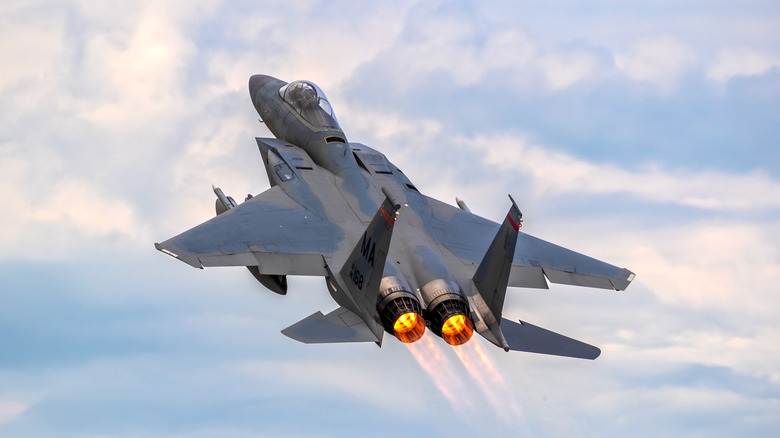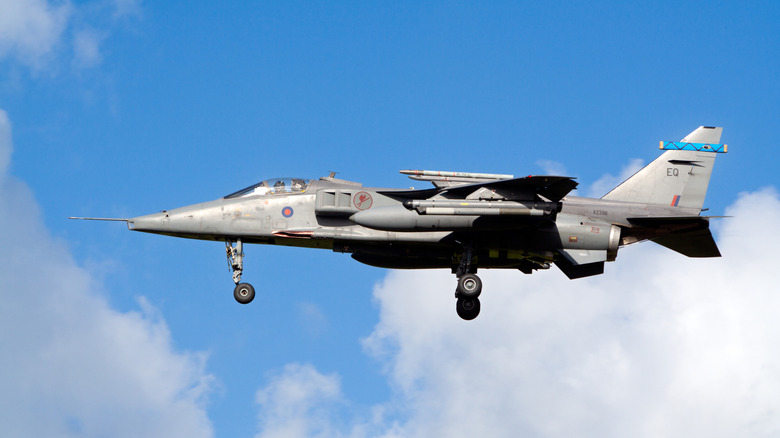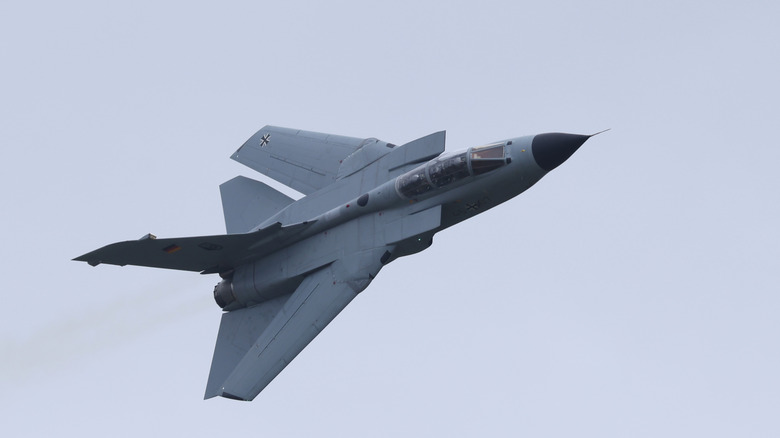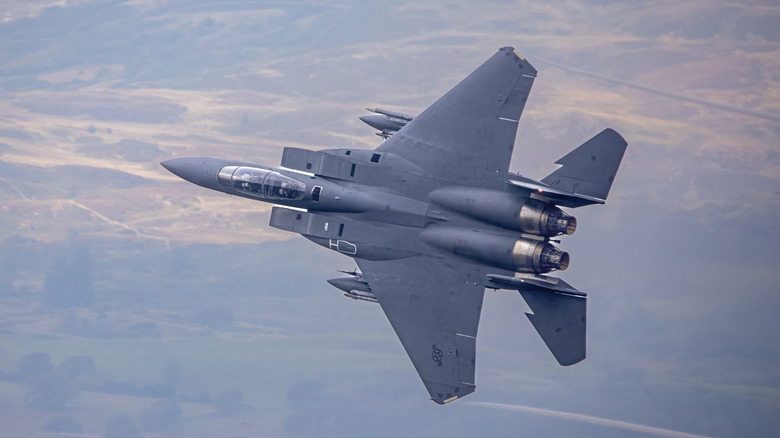5 1970s Fighter Jets That Are Still In Service
Building and developing a fighter jet is complicated and expensive. To make one that stays relevant for decades, while remaining cost-effective, and one that actually manages to pay itself off (through export, say) is about as common as the Tennessee Titans winning a game — it doesn't happen often. That expense barrier in particular is a key reason why so many jets developed way back in the 1970s are still in service and flying today. That decade gave us remarkable fighter aircraft that were so sound and well-engineered that they've refused to become obsolete. Only minor work and upgrades have been needed to keep these airframes up and running, with a couple of tech bits bolted on here and there.
Sure, name-brand companies keep coming up with new planes that cost a fortune, but air forces worldwide keep discovering that a well-maintained F-16 or F-15 still does the job rather brilliantly. And these aren't just Cold War relics held together by throwing money at them, despite defense budgets often being skewed toward the air force.
Some models are so well built that units from more than half a century ago are still flying. Others have designs so forward thinking that, with a couple of minor upgrades, they still remain competitive and are still being produced. Some nations operate these simply because they're good, while others keep them flying because they're forced to, often due to geopolitics.
Grumman F-14
The F-14 was developed by Grumman well before its 1994 merger with Northrop, and it quickly became a problem-riddled plane upon entering service back in the 1970s. The main issue was the shifting of aerodynamic lift force from roughly the middle toward the rear of the jet at supersonic speeds, which sometimes caused the plane to lose altitude. To remedy this, miniature flaps called vanes were added, and could be opened and shut by the pilot.
Another radical design choice for the F-14 was the variable-sweep wings, which allowed the wings on the F-14 to fold in response to the required aerodynamic profile. The debut generation, now called the F-14A came with two turbofan 414A engines made by Pratt & Whitney; though later variants like the F-14B (released 1987) switched to more powerful General-Electric F110 engines.
The latest version of the jet is the F-14D, which released toward the end of the 1980s, shipping with said F-110 engines from General-Electric. Each engine made 27,800 pounds of thrust with afterburners, gave the plane a service ceiling of more than 50,000 feet, and a range of 1,840 miles. Only Iran still uses the F-14 — the nation's now-ancient first-generation, pre-1979 F-14A airframes were purchased before the revolution, and the country has been unable to access more modern units because of various sanctions. The A-generation F-14s make 20,900 pounds of thrust with afterburners (per engine), and were powered by the TF30-414 units from Pratt & Whitney, as mentioned earlier.
SEPECAT Jaguar
There were almost two dozen variants of the Jaguar made between 1968 and 1981. Jointly designed and produced by a British-French company known as SEPECAT, the jet became the main aircraft of both countries' air forces, before being phased out for more modern offerings. The French would end up with three versions of the jet, designated the Jaguar A, E, and M; for use as a single-seat strike fighter, a two-seat trainer, and a naval-patrol jet respectively. It's worth noting that only the Jaguar A and Jaguar E entered mass-production. The British counterparts to the French were the Jaguar GR.1 and T.2, being a single-seat attack and a two-seat trainer, respectively.
Early variants used twin Mk 102 Adour engines jointly designed by Rolls-Royce and Turbomeca, which (in the single-seat variants) produced a grand total of 16,498 pounds of thrust and enabled the Jaguar to reach a top speed of 990 mph — Mach 1.3 — and gave the jet a range of 2,190 miles.
The service ceiling for the Jaguar was 45,930 feet, which it could reach in under three minutes thanks to its climb rate of 20,000 feet per minute. Though it was an advanced jet, eventually, most of the countries that adopted it phased the jet out, and the only country that still uses the SEPECAT Jaguar in 2025 is India.
Panavia Tornado
In 1969, Italy, West Germany, and the U.K. decided to develop a fighter aircraft together, and so the leading defense companies in each country – Aeritalia, Messerschmitt, and British Aviation, respectively — came together to form Panavia. Now owned by Airbus, BAE Systems, and Leonardo, Panavia produced the Tornado, which made its first flight in 1974, though deliveries only began in 1980. All variants of the Tornado were powered by the RB199 engine made by Turbo-Union, though different variants used different generations of the engine, each producing slightly different thrust.
The IDS used the Mk 103 (14,840 pounds of thrust per engine), the ECR came with the Mk 105 (17,300 pounds), and the Mk 104 (16,520 pounds) was used by ADV versions. For those wondering, IDS Tornados were intended for bomber roles, ECR versions were specialized reconnaissance aircraft, and ADV variants were interceptors. In terms of armaments, the Tornado can carry AIM-9 Sidewinder missiles, AAM 1,000-pound bombs, anti-ship missiles, and more, in addition to a 27mm gun.
Today, the Tornado remains in active service only with the Germans, wherein the most common is the IDS strike variant. This variant has a top speed of 1,688 mph (Mach 2.2), a range of 2,417 miles, and a service ceiling of 50,000 feet or more. However, it appears that the days of seeing the Tornado used by Germany are numbered, as the nation is aggressively purchasing new Eurofighter Typhoons in the hopes of retiring its Tornado fleet.
McDonnell Douglas F-15
The legendary F-15 may be the first mainstream fighter jet that people other than military buffs knew about. Over the years, this jet has earned itself the designation of "Strike Eagle," likely to recognize its first-strike capabilities. The latest generation of this jet is the F-15EX II; but there have been a number of others introduced through the years; namely the A, B, C, and D variants.
F-15s designated with model codes A through D were powered by the F100 engines from Pratt & Whitney that produce a combined 46,900 pounds of thrust (in the newer C and D versions). This power was enough to get the old F-15s to 1,875 mph (Mach 2.4), though a modern F-15's top speed is 2,302 mph (Mach 3)) with newer engines from General-Electric. Furthermore, the F-15 has a service ceiling of 65,000 feet, though its range would highly depend on what loadout it featured — a commonly quoted figure for C and D variants was 3,450 miles.
All of this combined makes the F-15 arguably the most dominant fighter jet that the U.S. Air Force has ever owned, and it has never been shot down in air-to-air combat. In 2025, it is still being used by the U.S., Japan, Israel, Saudi Arabia, Singapore, South Korea, and Qatar. As a matter of fact, the Kingdom of Qatar is still receiving new deliveries of a new version of the Strike Eagle, called the F-15QA.
Lockheed Martin F-16
Nicknamed the "Fighting Falcon," the F-16 is one of the most iconic fighters ever to take flight. Developed by Lockheed-Martin in top secret, the first F-16 deliveries were made to the U.S. Air Force in 1979. The F-16 is powered by a single engine, either a single Pratt & Whitney F-100 or General Electric F110, depending on the series. While exact figures vary by production generation, loadout, and mission profile, the F-16's range can exceed 2,000 miles with a service ceiling of 50,000 feet. The F-16 has a top speed of Mach 2.0 or 1,535 mph, which is impressive even today.
In addition to the M-61A1 cannon and multiple hardpoints for missiles and/or fuel tanks, F-16s are also pretty kitted out when it comes to tech, including advanced radar, enemy targeting, and electronic countermeasure systems. These beautiful jets are still in use by the U.S. and 28 other countries, including Turkey, Egypt, Pakistan, Israel, Greece, Taiwan, Singapore, the UAE, and Denmark, and more continue to be delivered.





